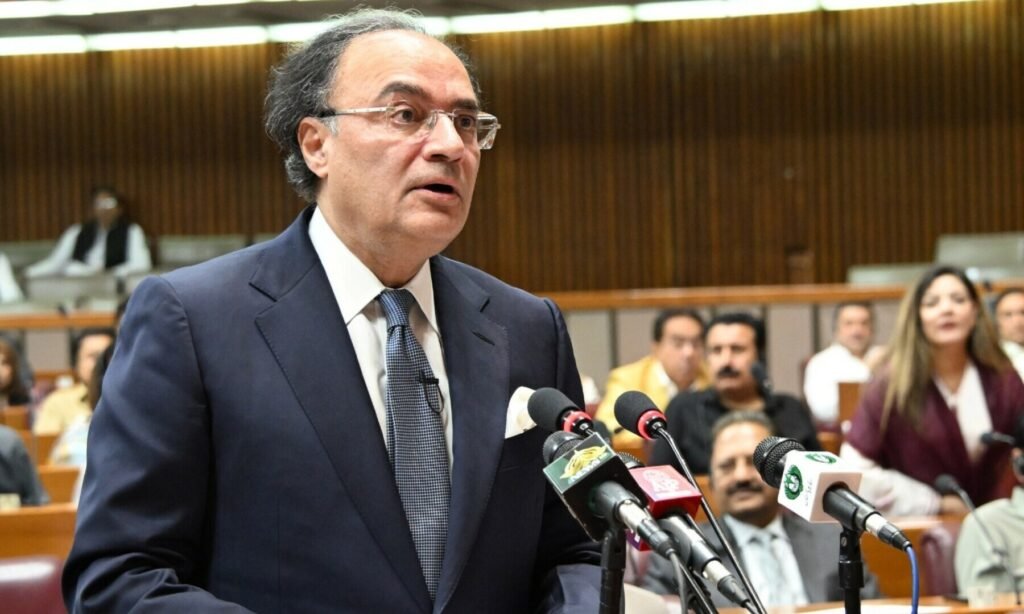
ISLAMABAD, PAKISTAN — Finance Minister Muhammad Aurangzeb on Tuesday unveiled Pakistan’s federal budget for fiscal year 2026 in a tumultuous National Assembly session, proposing a significant decrease in overall spending alongside ambitious growth and tax targets. The budget, with a total outlay of Rs17.573 trillion, marks a 6.9 percent reduction from the previous year, aiming for 4.2 percent economic growth.
Amidst anti-government sloganeering from opposition lawmakers, Finance Minister Aurangzeb began his speech by declaring the budget a “historic moment” rooted in national unity, drawing parallels with the recent Pakistan-India conflict. .
He asserted that having protected national sovereignty, the nation must now ensure its financial security. Despite the noise, he maintained that Pakistan has achieved economic stability and is on a path towards prosperity, citing a current account surplus, strong remittances, and rupee stability, alongside positive credit rating upgrades from Moody’s and Fitch.
Key Budget Figures and Targets:
- Total Outlay: Rs17.573 trillion (6.9% decrease from previous year).
- Current Expenditure: Rs16,286 billion (5.33% decrease).
- Debt Servicing (Interest Payments): Rs8,207 billion, consuming nearly half the total outlay and remaining the single largest expense.
- Defence Expenditure: Rs2,550 billion (20.2% higher than last year), constituting 1.97% of GDP.
- Tax-to-GDP Ratio Target: 14% (deemed “unavoidable”).
- FBR Tax Collection Target: Rs14,131 billion (8.95% increase from last year’s goal).
- Fiscal Deficit Target: 3.9% of GDP (Rs5,037 billion), down from 5.9% last fiscal year.
- Inflation Target: 7.5% for the next fiscal year.
- Total Revenue FY25: Rs19,278 billion (Net revenue after provincial transfers: Rs11,702 billion, a 6.7% increase).
FBR Transformation and Revenue Measures:
Aurangzeb stressed that achieving national targets was “impossible without the transformation of the Federal Board of Revenue (FBR).” Planned reforms include B2B e-voicing, AI-based audit selection systems, e-billing, faceless audits, and a new central control unit for centralized data collection.
He highlighted the identification of 390,000 high-value non-filers and a 100% increase in tax filers, contributing Rs105 billion in revenues. The minister also noted the IMF’s acknowledgment of Rs389 billion in revenues through law enforcement. Taking a jab at “alarmists,” he affirmed that no “mini-budget” had been implemented.
Energy Sector Reforms and Investment:
The Finance Minister announced a 31% reduction in electricity prices and a 50% reduction for protected consumers. He mentioned the privatization of distribution companies and plans to “procure cheap energy,” citing the closure of costly power plants and interest from Turkish and other international companies for investment.
Rs90.2 billion has been allocated to 47 energy schemes, including significant funds for the Tarbela 5th Extension, Dasu hydel project, Suki-Kinari Hydropower Project, and Momand hydel dam.
Key Development Projects and Initiatives:
- Reko Diq Project: Termed a “game changer,” expecting $71 billion in cash flows, $7 billion in tax, and $8 billion in royalties. Feasibility study completed in January.
- Tariff Reforms: Additional customs duties ending in four years, regulatory duties in five years, Customs Act’s Schedule 5 eliminated in five years, and customs duty structured in slabs with a maximum of 15%.
- Debt Management: Debt-to-GDP ratio reduced to below 70% from 74% two years ago, with plans for further reduction and diversification of debt products like Sukuk bonds.
- State-Owned Enterprises (SOEs): Reforms underway, with PIA and Roosevelt Hotel transactions expected this year.
- Pension Reforms: Pension increases linked to the Consumer Price Index (CPI).
- Climate Change: Acknowledged vulnerability, citing IMF’s $1.3 billion climate fund and national water policy goals. Rs133 billion allocated for water projects.
- Social Protection: BISP supported over 11 million children’s schooling, 1.5 million pregnant mothers and children received funds, and 250,000 received financial literacy training.
- Digital Sector: Cybersecurity ranking rising, IT exports up 21.2% to $3.1 billion in 10 months, target of $25 billion in next five years.
- SME Support: SME Development Authority launched a three-year financing plan, Rs300 billion provided to 95,000 SMEs by May 2025.
- Housing: Planned scheme for purchase of cheap houses.
- Overseas Pakistanis: Remittances surged by 31% to $31.2 billion, with steps like online systems, civil procedure laws, medical school quotas, and civil awards for top senders.
- Agriculture: Green Pakistan Initiative, focus on genetic improvement and post-harvest processes, 1,000 agriculture graduates sent to China, five new livestock schemes. Rs2.64 billion earned in FY24-25.
- Education: HEC to receive Rs39.5 billion for 170 projects; Rs9.8 billion for 11 new Daanish Schools.
- Health: Rs14.3 billion for 21 schemes, including Rs4 billion for Jinnah Medical Complex, Rs1 billion for hepatitis eradication, Rs800 million for diabetes prevention, and Rs900 million for Pims stroke center.
- Regional Allocations: Rs164 billion for development projects; Rs48 billion each for AJK and GB, Rs68 billion for KP’s merged districts.
Earlier in the day, Prime Minister Shehbaz Sharif, following a cabinet meeting, questioned the contributions of the country’s elite economic group to the national exchequer.
He highlighted the sacrifices made by the common and salaried classes, contrasting them with the contributions of the wealthy, stating, “This is a question that the elite, including me, have to answer.”
The premier expressed optimism, noting that Pakistan was “standing at a point where we have to take off,” with satisfactory stability indicators across inflation, policy rates, exports, remittances, and IT exports.

